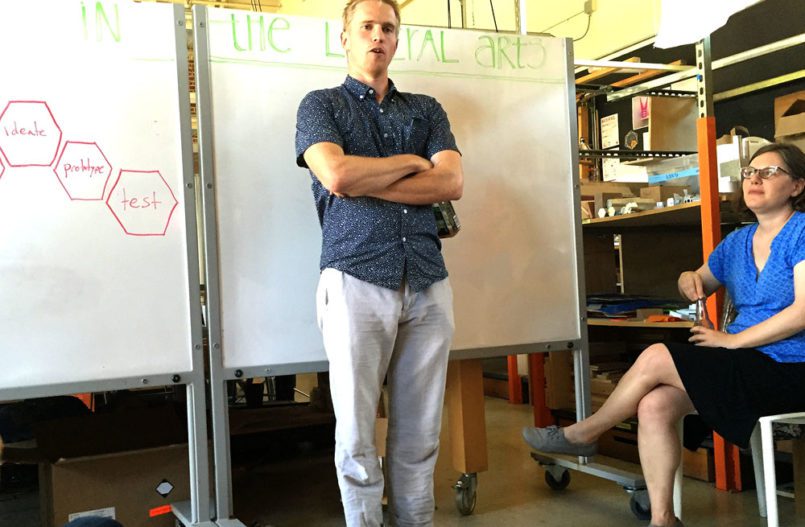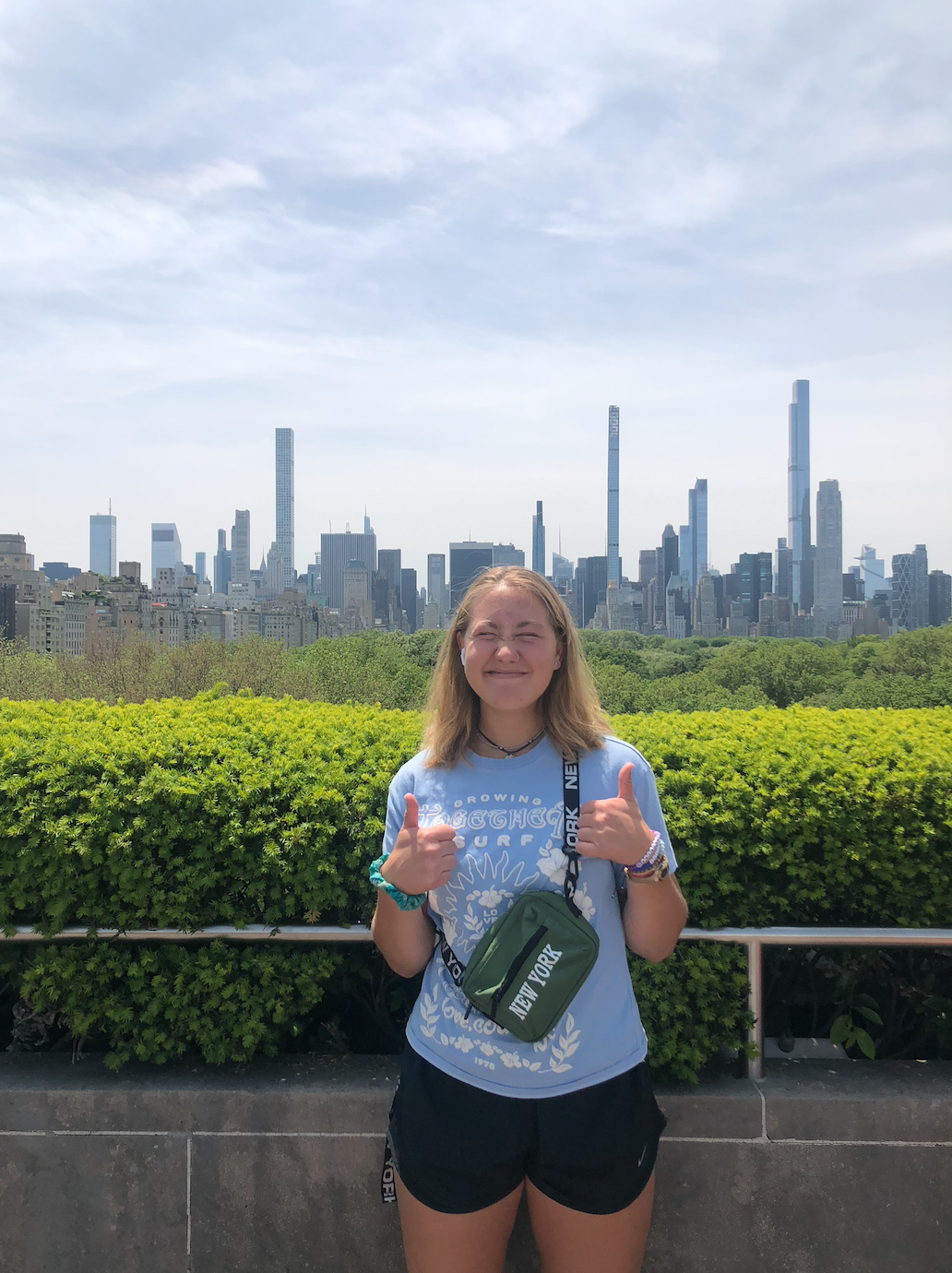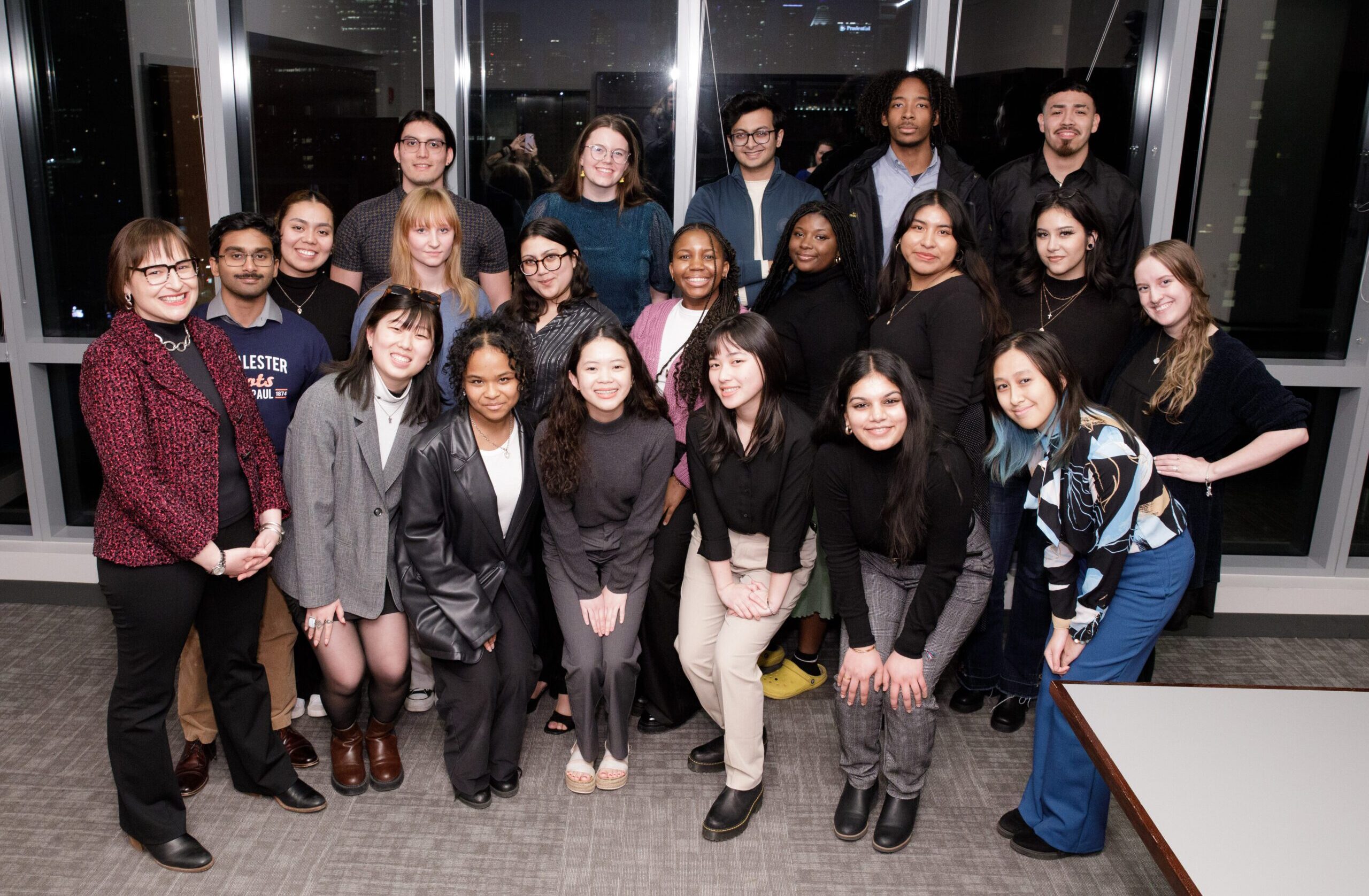Faculty in Silicon ValleyDaily posts and photos from the ACM SAIL faculty seminar on Silicon Valley as an Innovation Ecosystem. |
Day 5 – Friday, July 15, 2016
Posted by Michelle Mouton, Professor of English, Cornell College
It’s 10 p.m. or so, and dark, and Will Meadows, Lawrence University B.A. and Stanford University M.F.A., jumps up from a congenial circle of eight or nine Stanford Design School students and a couple of ACM faculty seated on his wooden deck to say goodnight with a warm hug to those of us heading out. Other folks congregate on the wooden decks overhung with wisteria vines and strings of lights, or lean on the bar next to the cooling outdoor grill. It’s too dark now to see the pear, apple, fig, orange, lime and persimmon trees, but they’re all around us in this Palo Alto backyard. We’re feeling relaxed, tired, and strangely happy — or at least I am — nearing the end of a full and productive week.
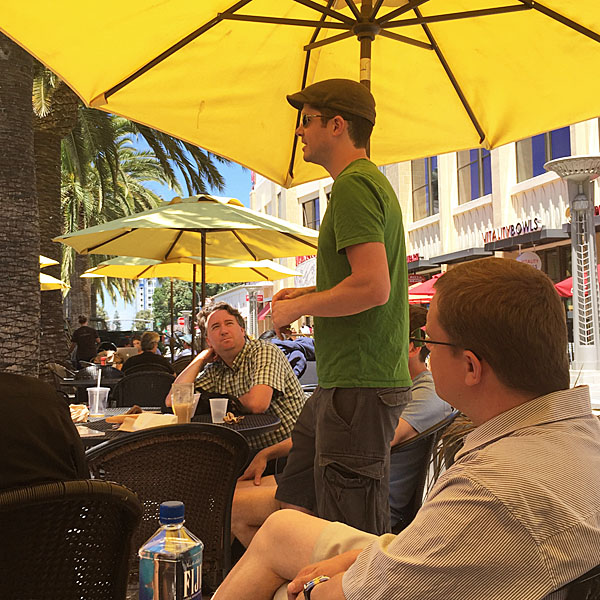 Lawrence alumnus John Gale talking about his experience working at Apple.
Lawrence alumnus John Gale talking about his experience working at Apple.
At this point in the trip, it’s impossible not to be astonished at the talent, creativity, authenticity, and generosity of the many ACM alumni who’ve hosted us, all sharing their experiences with innovation in Silicon Valley. This morning, Akwasi Asabere (Knox) introduced us to the founders of the ambitious bio-tech start-up Helix. Over lunch, John Gale (Lawrence University) shared experiences working for Apple. And before hosting us at his home for a BBQ dinner, Will gave us a hands-on experience by leading a design-thinking workshop, Stanford d.school style, to help us generate ideas on how we might incorporate innovation in our teaching.
Lost (and found) in Helix
My morning visit to Helix started inauspiciously when I found myself separated from the group. Maybe I was disoriented by the high-security sign-ins required to enter the building, or I lingered too long in the powder room ogling the high-tech, luxury-level Japanese-designed toilets and imagining what kinds of biotech incidents might spur the company to provide first-aid kits in addition to more commonly encountered free tampons, mouthwash, and hair products. Whatever the case, when I enter the office space, I found myself without a crew.

“I think they went that way,” someone says. So I walk around the donut-shaped floor of the building, an open floor plan, trying not to look too lost as employees type away, or chat over monitors. I overhear snippets of a performance review happening. I make a mental note that this is the first open-floor facility we’ve seen with a significant amount of face-to-face collaboration happening. I try to see into peripheral offices through frosted glass as I circled around, pass more work stations, walk through the well-stocked free snacks kitchen that we’ve been invited to use, walk past the board-game and ping-pong corner (presently unused), and find myself back at the beginning. I begin to get slightly nervous about security. The casual clothing and snacks belie that this is cutting-edge biotech research — serious business — and I probably shouldn’t be wandering around unescorted.
Thankfully, Mollie responded to my call for help on Slack (our trusty mobile collaboration tool), and was able to guide me to the “Board Room.” The name is hand-written on a white sheet of paper and taped to one of the frosted glass windows. (Silicon Valley is filled with temporary signage, indicative of the start-up culture that self-consciously values velocity over rootedness.) I enter in time to catch the beginning of the company’s passionate and energetic founders, who are describing how they came to the idea of starting Helix.
Seeing the future in a start-up’s business plan
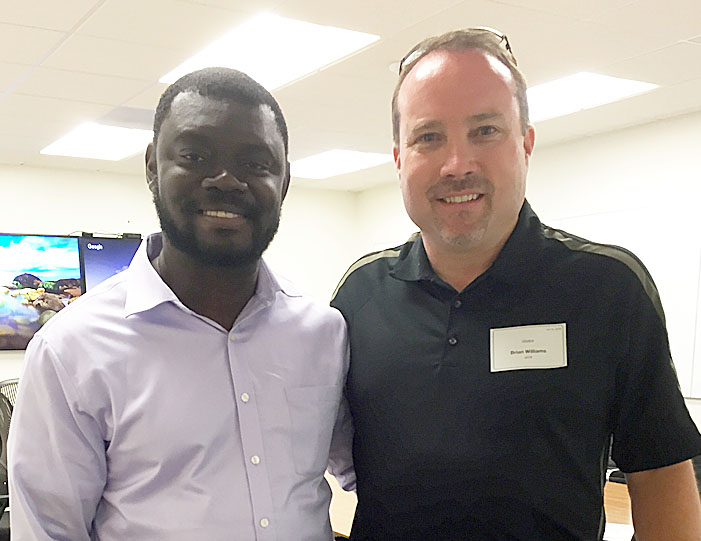 Knox alumnus Akwase Asabere and Brian Williams from ACM
Knox alumnus Akwase Asabere and Brian Williams from ACM
After they headed out for other meetings, Akwasi spoke with us at length about the start-up’s business plan and his role in acquiring and cultivating partnerships in the medical and commercial sectors. Helix’s eventual goal is to sequence whole genomes at individuals’ requests for around $100, using the best sequencing technology available, and storing this data indefinitely. Partners, like the Mayo Clinic, would then be able to interpret the genetic data whenever a client had a question about her or his genetic code.
While other companies like National Geographic or Ancestry presently offer to read parts of the genome sequence and provide information about geographical or ethnic heritage, those models don’t acquire and keep enough genetic information on participating individuals to be able to answer questions in the future. That would require doing another, fuller sequencing. Helix envisions a day when a phone app will allow us nearly instant access to individualized, professionally-interpreted genomic information because our information will already be stored in their databases.
Being academics, we quizzed Akwasi about privacy issues, partnership models, possible future plans for tackling epigenetics, the culture of Silicon Valley, and more. I left feeling that whatever concerns I might have about this science fiction vision of the future, it’s not very far away, and it was fascinating to gain access to the company’s perspective first hand.
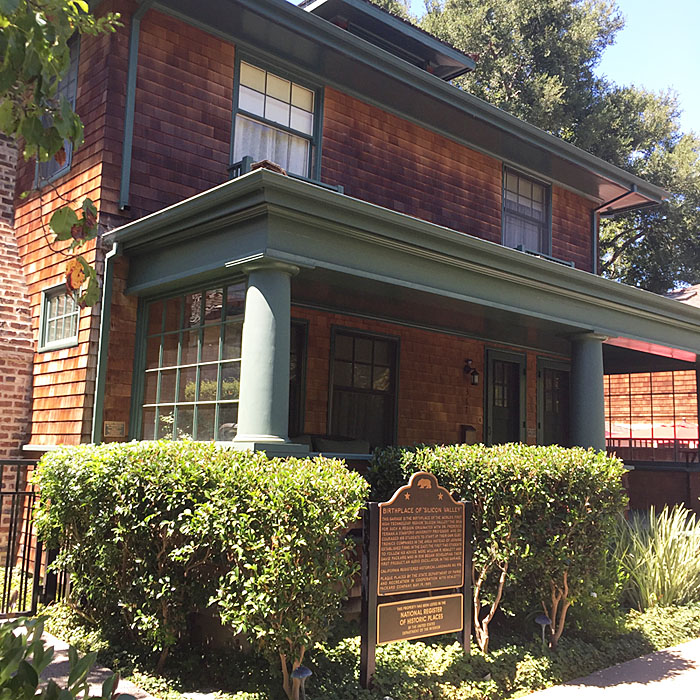 Marker for the site of the garage where Hewlett-Packard was started, the mythic birthplace of Silicon Valley.
Marker for the site of the garage where Hewlett-Packard was started, the mythic birthplace of Silicon Valley.
Apple, improv, and iconic garages
We’d heard about Apple through employees of Google and LinkedIn, and because it’s such a secretive company we couldn’t visit, so it was helpful to hear John Gale describe his experiences as a seven-year Apple employee.
After lunch, and a quick drive to see the famous garages that have been mythologized as the birthplace of Silicon Valley (Apple; HP), it was back to Stanford, where Will showed us the d.school’s maker spaces and led a workshop in design thinking. He managed to get the faculty moving, doing improvisational theatre and cross-interviews, aimed at generating new ideas on innovation in our colleges and classrooms.
Circling back to the liberal arts
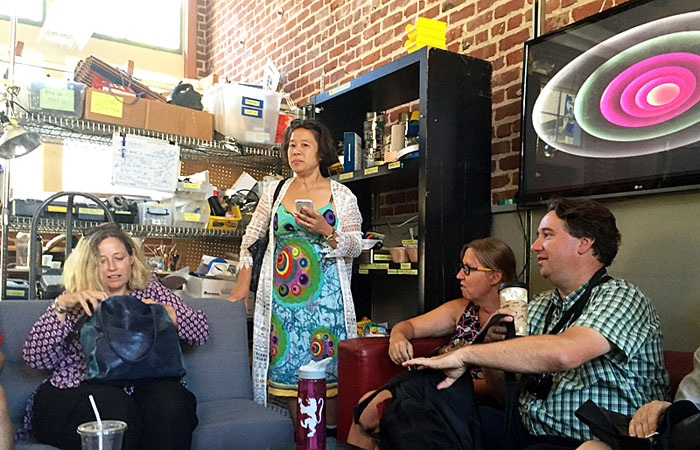 Faculty try out some improv as part of the design-thinking session led by Will Meadows.
Faculty try out some improv as part of the design-thinking session led by Will Meadows.
Throughout our time meeting with ACM alumni, we’ve continually asked, “What assets did your liberal arts education provide, and not provide that you wish it had, as related to your work in Silicon Valley?” We have received varied, and generally compatible, answers: The ability to identify and approach problems — to identify the problem, break it down into manageable parts, and take them on one by one. How to ask good questions. How to write and communicate well. Interdisciplinary thinking. How to work effectively in small groups. And so forth.
At times I felt that I was listening to ads for the liberal arts that we’d written ourselves. But the replies were thoughtful and backed up by concrete examples. Their stories have been informative and fascinating. And a constant theme has been the desire to do good through technology, science, and research. But it might be these alumni’s generosity in sharing their time, experiences, workplaces, and homes with us that has been most persuasive: ACM colleges seem to be doing something right.






